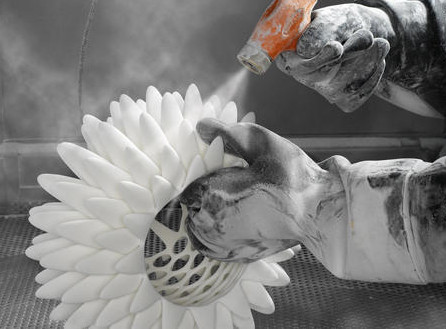TPU Material Details

General Information
Finding flexible materials suitable for 3D printing remains a challenge, especially for those in fields like biomedical engineering and research. FDM-printed TPU, short for Thermoplastic Polyurethane, offers a durable solution for components requiring rubber-like properties and flexibility.
Key Characteristics:
- Impressive Flexibility: TPU exhibits remarkable flexibility, allowing it to withstand considerable stretching—up to 300% elongation—before showing signs of wear and tear.
- Wide Array of Applications: In additive manufacturing, TPU finds extensive use across diverse applications. Some notable examples include shoe soles, tire prototypes, functional components, and even smartphone protective cases. TPU's ability to absorb heavy impacts without damage makes it a suitable choice for protective enclosures.
- High Surface Friction: TPU's notable high surface friction properties make it an excellent choice for crafting items like conveyor belts and friction clutches, where grip and durability are paramount.
Considerations:
While TPU boasts many advantages, it's important to note that it has a relatively high moisture absorption rate, which can impact its performance over time. When considering TPU for your 3D printing needs, it's crucial to assess your specific requirements and the potential effects of moisture exposure.
TPU stands as a versatile material in the realm of 3D printing, offering a blend of flexibility, resilience, and durability. Its applications span various industries.
Printing in TPU
Minimum Wall: 1 mm
Smalest Detail: 0.4 mm
Layer hight: 0.2mm
Max Print size: 256 x 256 x 256 mm
Tollerance: 0.2% min ±0.3 mm
Delivery Times: Typicaly 4-5 Businessdays

Pro`s and Con`s
Pro
- Flexibility: TPU (Thermoplastic Polyurethane) stands out for its remarkable flexibility, making it ideal for applications requiring rubber-like properties.
- Abrasion Resistance: TPU is highly resistant to abrasion, ensuring durability in demanding environments.
- Exceptional Elongation: TPU boasts an extraordinarily high elongation capability, allowing it to stretch extensively without breaking.
- Chemical Resistance: It exhibits strong chemical resistance, ensuring that TPU remains stable even in the presence of various chemicals.
Con
- Limited Resolution in FDM 3D Printing: When using Fused Deposition Modeling (FDM) technology, TPU may have limitations in achieving fine resolutions, affecting intricate detailing in prints.
- High Moisture Absorption: TPU has a tendency to absorb moisture, which can influence its mechanical properties over time.
- Reduced Layer Adhesion: The adhesion between layers in TPU 3D prints can be diminished, potentially affecting the structural integrity of the final product.
Applications of TPU 3D Print
Examples of Use:
- Flexible Prototypes: TPU is well-suited for creating flexible prototypes, which can be valuable in research and development across various industries. For instance, in biomedical engineering, flexible prototype components for medical devices or prosthetics can be efficiently developed using TPU.
- Bump Stops: In automotive and mechanical engineering research, TPU can be used to produce bump stops, aiding in shock absorption and impact resistance. This can be particularly relevant in the development of vehicle suspension systems.
- Shoe Soles: TPU's exceptional flexibility and durability make it an ideal choice for crafting shoe soles, ensuring comfort and longevity. This application is crucial in the footwear industry, where biomechanics research often informs sole design.
- Wheels and Tires: TPU's abrasion resistance and high elongation make it a suitable material for manufacturing wheels and tires. In the healthcare sector, TPU wheels on medical carts or equipment can enhance mobility and minimize noise levels in healthcare facilities.
- Chair Feet: TPU can be applied to create chair feet, offering floor protection and noise reduction. In laboratory environments, where precision and silence are paramount, TPU chair feet can be used to reduce disturbance and protect delicate surfaces.
Technical specifications
General Properties
Property | Test Method | Value |
Density | ISO1183, GB/T1033 | 1.20-1.24 g/cm³ at 23°C |
Melting Point | 210°C, 2.16kg | 3-6 g/10min |
Light Transmission | N/A | N/A |
Flame Resistance | N/A | N/A |
Moisture Absorption | 70%RH – 23°C | 0.82% |
Mechanical Properties
Property | Test Method | Value |
Elastic Modulus (X-Y) | ISO 527, GB/T 1040 | 9.4 ± 0.3 MPa |
Elastic Modulus (Z) | ISO 527, GB/T 1040 | N/A |
Tensile Strength (X-Y) | ISO 527, GB/T 1040 | 29 ± 2.8 MPa |
Tensile Strength (Z) | ISO 527, GB/T 1040 | N/A |
Elongation at Break (X-Y) | ISO 527, GB/T 1040 | 330.1 ± 14% |
Elongation at Break (Z) | ISO 527, GB/T 1040 | N/A |
Flexural Modulus (X-Y) | ISO 178, GB/T 9341 | N/A |
Flexural Modulus (Z) | ISO 178, GB/T 9341 | N/A |
Flexural Strength (X-Y) | ISO 178, GB/T 9341 | N/A |
Flexural Strength (Z) | ISO 178, GB/T 9341 | N/A |
Impact Strength (Charpy X-Y) | ISO 179, GB/T 1043 | N/A |
Impact Strength (Charpy Z) | ISO 179, GB/T 1043 | N/A |
Thermal Properties
Property | Test Method | Value |
Glass Transition Temperature | DSC, 10°C/min | N/A |
Melting Temperature | DSC, 10°C/min | N/A |
Crystallization Temperature | DSC, 10°C/min | N/A |
Decomposition Temperature | TGA, 20°C/min | N/A |
Vicat Softening Temperature | ISO 306, GB/T 1633 | N/A |
Heat Deflection Temperature (1.8MPa) | ISO 75 | N/A |
Heat Deflection Temperature (0.45MPa) | ISO 75 | N/A |
Thermal Conductivity | N/A | N/A |
Thermal Shrinkage Rate | N/A | N/A |


